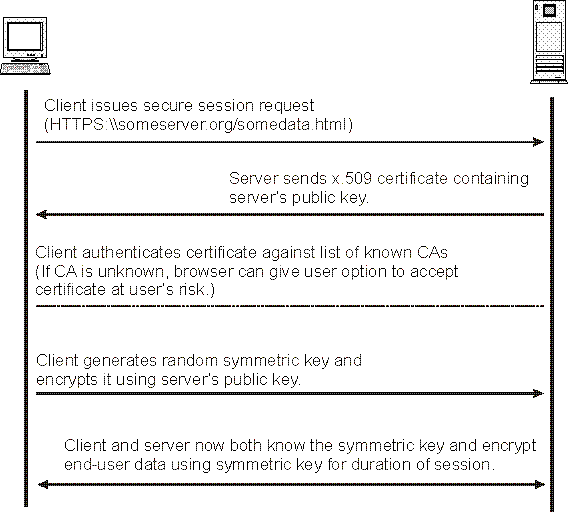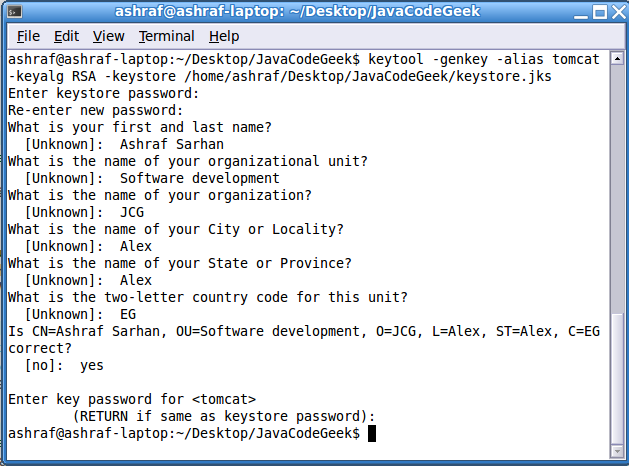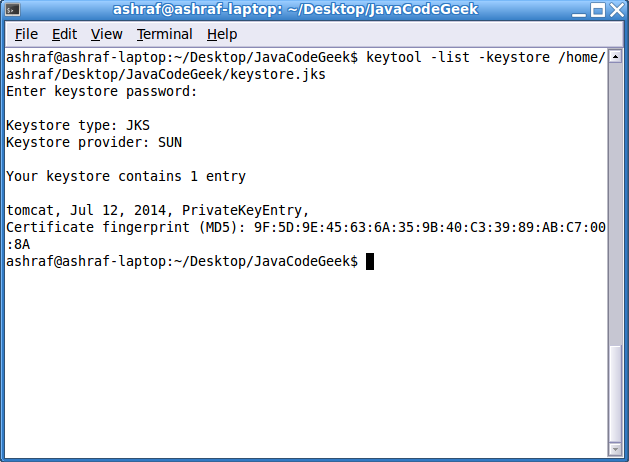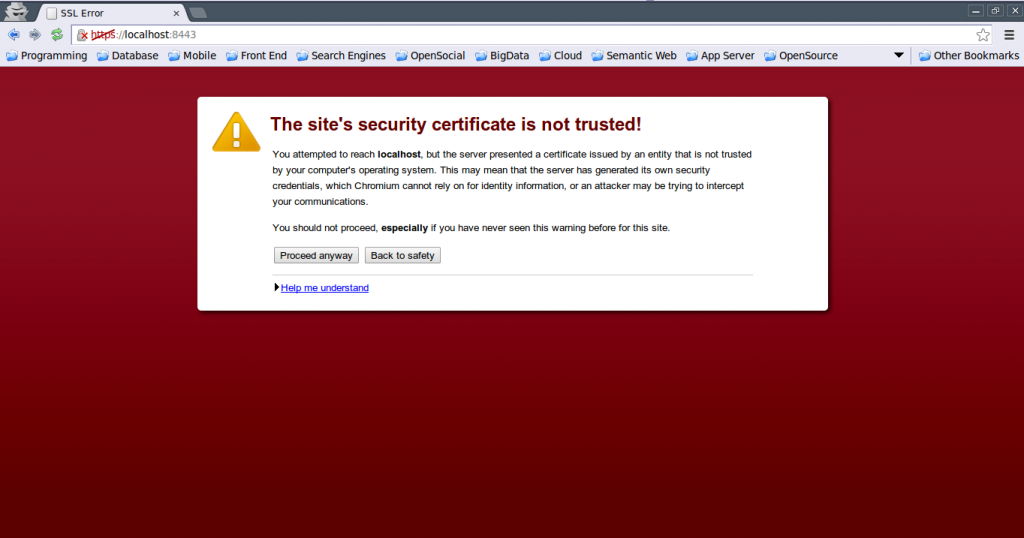Java Keystore Tutorial
Table Of Contents
1. Introduction
Who of us didn’t visit ebay, amazon to buy anything or his personal bank account to check it. Do you think that those sites are secure enough to put your personal data like (credit card number or bank account number, etc.,)?
Most of those sites use the Socket Layer (SSL) protocol to secure their Internet applications. SSL allows the data from a client, such as a Web browser, to be encrypted prior to transmission so that someone trying to sniff the data is unable to decipher it.
Many Java application servers and Web servers support the use of keystores for SSL configuration. If you’re building secure Java programs, learning to build a keystore is the first step.
2. SSL and how it works
A HTTP-based SSL connection is always initiated by the client using a URL starting with https:// instead of with http://. At the beginning of an SSL session, an SSL handshake is performed. This handshake produces the cryptographic parameters of the session. A simplified overview of how the SSL handshake is processed is shown in the diagram below.
This is in short how it works:
- A browser requests a secure page (usually https://).
- The web server sends its public key with its certificate.
- The browser checks that the certificate was issued by a trusted party (usually a trusted root CA), that the certificate is still valid and that the certificate is related to the site contacted.
- The browser then uses the public key, to encrypt a random symmetric encryption key and sends it to the server with the encrypted URL required as well as other encrypted http data.
- The web server decrypts the symmetric encryption key using its private key and uses the symmetric key to decrypt the URL and http data.
- The web server sends back the requested html document and http data encrypted with the symmetric key.
- The browser decrypts the http data and html document using the symmetric key and displays the information.
The world of SSL has, essentially, three types of certificates: private keys, public keys (also called public certificates or site certificates), and root certificates.
3. Private Keys
The private key contains the identity information of the server, along with a key value. It should keep this key safe and protected by password because it’s used to negotiate the hash during the handshake. It can be used by someone to decrypt the traffic and get your personal information. It like leaving your house key in the door lock.
4. Public Certificates
The public certificate (public key) is the portion that is presented to a client, it likes your personal passport when you show in the Airport. The public certificate, tightly associated to the private key, is created from the private key using a Certificate Signing Request (CSR). After you create a private key, you create a CSR, which is sent to your Certificate Authority (CA). The CA returns a signed certificate, which has information about the server identity and about the CA.
5. Root Certificates
Root CA Certificate is a CA Certificate which is simply a Self-signed Certificate. This certificate represents a entity which issues certificate and is known as Certificate Authority or the CA such as VeriSign, Thawte, etc.
6. Certificate Authorities
Companies who will sign certificates for you such as VeriSign, Thawte, Commodo, GetTrust. Also, many companies and institutions act as their own CA, either by building a complete implementation from scratch, or by using an open source option, such as OpenSSL.
7. Certificate Chain
When a server and client establish an SSL connection, a certificate is presented to the client; the client should determine whether to trust this certificate, a process called the certificate chain. The client examines the issuer of a certificate, searches its list of trusted root certificates, and compares the issuer on the presented certificate to the subjects of the trusted certificates.
If a match is found, the connection proceeds. If not, the Web browsers may pop up a dialog box, warning you that it cannot trust the certificate and offering the option to trust the certificate.
8. Keystore using Java keytool
Java Keytool is a key and certificate management utility. It allows users to manage their own public/private key pairs and certificates. Java Keytool stores the keys and certificates in what is called a keystore. It protects private keys with a password.
Each certificate in a Java keystore is associated with a unique alias. When creating a Java keystore you will first create the .jks file that will initially only contain the private key, then generate a CSR. Then you will import the certificate to the keystore including any root certificates.
9. Keystore Commands
Create Keystore, Keys and Certificate Requests
- Generate a Java keystore and key pair
keytool -genkey -alias mydomain -keyalg RSA -keystore keystore.jks -storepass password
- Generate a certificate signing request (CSR) for an existing Java keystore
keytool -certreq -alias mydomain -keystore keystore.jks -storepass password -file mydomain.csr
- Generate a keystore and self-signed certificate
keytool -genkey -keyalg RSA -alias selfsigned -keystore keystore.jks -storepass password -validity 360
Import Certificates
- Import a root or intermediate CA certificate to an existing Java keystore
keytool -import -trustcacerts -alias root -file Thawte.crt -keystore keystore.jks -storepass password
keytool -import -trustcacerts -alias mydomain -file mydomain.crt -keystore keystore.jks -storepass password
Export Certificates
- Export a certificate from a keystore
keytool -export -alias mydomain -file mydomain.crt -keystore keystore.jks -storepass password
Check/List/View Certificates
- Check a stand-alone certificate
keytool -printcert -v -file mydomain.crt
- Check which certificates are in a Java keystore
keytool -list -v -keystore keystore.jks -storepass password
- Check a particular keystore entry using an alias
keytool -list -v -keystore keystore.jks -storepass password -alias mydomain
Delete Certificates
- Delete a certificate from a Java Keytool keystore
keytool -delete -alias mydomain -keystore keystore.jks -storepass password
Change Passwords
- Change a Java keystore password
keytool -storepasswd -new new_storepass -keystore keystore.jks -storepass password
- Change a private key password
keytool -keypasswd -alias client -keypass old_password -new new_password -keystore client.jks -storepass password
10. Configure SSL using Keystores and Self Signed Certificates on Apache Tomcat
- Generate new keystore and self-signed certificateusing this command, you will prompt to enter specific information such as user name, organization unit, company and location.
keytool -genkey -alias tomcat -keyalg RSA -keystore /home/ashraf/Desktop/JavaCodeGeek/keystore.jks -validity 360
- You can list the certificate details you just created using this command
keytool -list -keystore /home/ashraf/Desktop/JavaCodeGeek/keystore.jks
- Download Tomcat 7
- Configure Tomcat’s server to support for SSL or https connection. Adding a connector element in Tomcat\conf\server.xml
<Connector port="8443" maxThreads="150" scheme="https" secure="true" SSLEnabled="true" keystoreFile="/home/ashraf/Desktop/JavaCodeGeek/.keystore" keystorePass="password" clientAuth="false" keyAlias="tomcat" sslProtocol="TLS" />
- Start Tomcat and go tohttps://localhost:8443/, you will find the following security issue where the browser will present untrusted error messages. In the case of e-commerce, such error messages result in immediate lack of confidence in the website and organizations risk losing confidence and business from the majority of consumers, that’s normal as your certificate isn’t signed yet by CA such as Thawte or Verisign who will verify the identity of the requester and issue a signed certificate.

- You can click Proceed anyway till you receive you signed certificate.







Very interesting article – would it be possible to share an image which explains / shows a mutual authentication? In other words, steps when a server has to validate clients as well.
Thanks in advance.
Just, take a look on this image which explains the mutual authentication.
http://examples.javacodegeeks.com/wp-content/uploads/2014/08/mutualssl.png
Hi Ashraf,
It’s very nice article. I worked with you in pivotal office couple of months ago. I was looking for a smart solution for below. Help will be really appreciated. I need to make a “webservicetemplate” ssl soap service invocation where I have jks file and password with me. Looking for best solution with annotations and spring properties.
Nice article! I would like to indicate the tool kse (keyStore explorer) at sourceforge. Not affiliate in any way but it sure makes it easier to understand the concepts since the GUI hides the command line, intimidating at first for some.
Nothing wrong with command line , I use myself everyday and should be the preferred way in a production server, but a GUI helps while one is not familiar with the concepts.
Kudos for your addition, It’s a good idea to use the GUI tool specially for beginners.
Also, I forgot:
Whats up with that spy at the browser window? is some theme, plugin, or something, hummm…, else ? :)
Regarding the spy sign at the top left of the browser window, That’s because I had opened the Chromium in incognito mode.
It’s a good point, it adds more security stack. Just, take a look on this image which explains the mutual authentication.
http://examples.javacodegeeks.com/wp-content/uploads/2014/08/mutualssl.png
Very nice article. Also thanks for sharing the diagram on mutual authentication. I have a question on enryption though. specifically this point:
==
The browser then uses the public key, to encrypt a random symmetric encryption key and sends it to the server with the encrypted URL required as well as other encrypted http data
==
If the URL is also encrypted, how will domain name resolution happen as the DNS server can not decrypt the URL since only the private key can do the same and that is available only with the origin server.
-Prasad
Thanks for raising this point. Although the https guarantees the encrypted secure connection where the whole URL with its data are encrypted, DNS lookup request which resolves the domain name like “javacodegeeks.com” to numbers like “64.64.30.146” is sent through a separate unencrypted traffic before encrypting the URL, leaving you open to spoofing and man-in-the-middle attacks. DNSCrypt can lock that down.
Thanks for your response. On DNSCrypt, does it come integrated with browsers or is it an add-on? How can it be plugged in when a user wants to access a secure site?
-Prasad
You will find more information here https://www.opendns.com/about/innovations/dnscrypt
I also wanted to know which ciphers and hashing are used in the SSL communication.
It was build on the Public-key cryptography (asymmetric) which uses encryption algorithms like RSA and Elliptic Curve Cryptography (ECC) to create the public and private keys. With asymmetric encryption it is computationally easy to generate public and private keys, encrypt messages with the public key, and decrypt messages with the private key. However, it is extremely difficult (or impossible) for anyone to derive the private key based only on the public key.
for relative urls on an html page [ones of the type “../images/someImage.jpg”], will the browser fetch them on a secure channel? was curious to know how it is accomplished.
Any time an HTML image link is created within a page using the entire, “absolute” URL for the image file’s location, the resulting image link will not be encrypted by any SSL on the site.
For example, the following image link cannot be encrypted by an SSL certificate:
To correct this issue, simply remove your store’s domain from the image tag, creating a relative link:
Sorry, I think the comment doesn’t accept HTML elements! BTW, I mean that you should have the images hosted on your store, then you can use the relative link “/assets/photo1.jpg” instead of “absolute” URL like “http://www.yourvolusionstore.com/assets/photo1.jpg”. Also. if you have an image which hosted on a web server outside your store (e.g. a Flickr account), you’ll need to modify the “absolute” image link to use the secure “https” protocol and the hosting server in question must support the “https” protocol.
Hi,
I am created my own keystone using RSA algorithm,
I am encryption and decryption small data is fine, but I try to encrypt long data(my data having a 5725 characters), I am getting “java.lang.ArrayIndexOutOfBoundsException: too much data for RSA block” exception in java. please help me how to solve this problem.
I think this a common issue with RSA in Java, take a look on this http://stackoverflow.com/questions/16546959/how-to-do-encryption-and-decryption-of-a-file/16547038#16547038
Hi Ashraf,
I am trying to create sso login using cas for some of the applications in Tomcat.
I have built cas and have deployed the cas on Tomcat 7.0
Can you please tell me about the configurations to be made for the applications in Tomcat to get SSO Login through cas.
Regards,
Chethan SK
I don’t have any experience with the CAS tomcat configuration but you can take a look on this https://wiki.jasig.org/display/CASC/Tomcat+Container+Authentication
Dear Ashraf,
i’ve tried to generate a new jks file but the password that i use recently can’t be identify. How do i check the password that i used before?
TQ.
You can check your certificate using “keytool -list -v -keystore keystore.jks” and you will be asked for the password but if you forgot it, you can generate your jks again.
Excellent explanation.
Thanks
Artical was so good.
When I read first tiem I was confuced the phrase “random symmetric encryption key”. Had to read another article to understand what it is. BTW simple understandable article
Thanks Ashraf for the nice explanation.
I was trying (enabling the SSL on tomcat) with my local machine and ec2-instance , on local machine it works perfectly fine but when i did it on my ec2-instance and try to access the url with 8443 . i get below error
On chrome :- ERR_SSL_VERSION_OR_CIPHER_MISMATCH
On mozzile :- cannot communicate securely with peer: no common encryption algorithm(s). Error code: SSL_ERROR_NO_CYPHER_OVERLAP .
let me know what is reason behind getting the error on ec2-instance and not locally and how to fix it.
Thanks in advance,
Amit
There are many kinds of keystores supported by Java. For example, JKS, JCEKS, PKCS12 etc. Here is a great post I find which describes different keystores. http://www.pixelstech.net/article/1408345768-Different-types-of-keystore-in-Java—-Overview
This was very very helpful for me, Highly appreciate the good work..